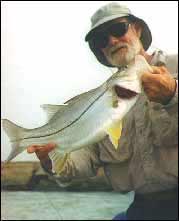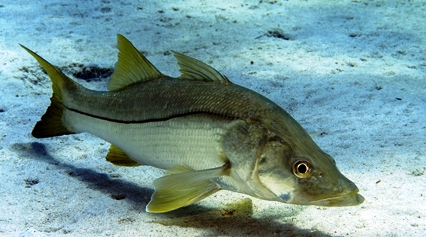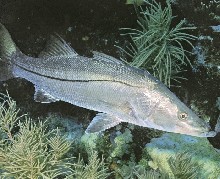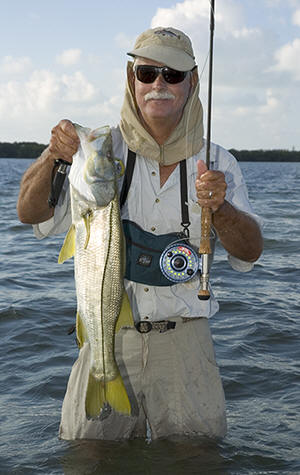Discover Florida Nature
It's time to explore the natural Florida


|
|
|
|
|
 Fat
Snook (Centropomus parallelus) Snook are
inshore fish with an attitude. They are generally a golden yellow in
color with a dark black lateral line (stripe) running the length of
their body. Their mouth is similar to a large mouth bass' size & shape,
yet their gills are razor sharp so watch out when handling these guys.
The fat snook has a deeper body than other snooks. The color of the fat
snook is yellow-brown to green-brown above, with a silvery shade on it's
sides. The standard black lateral line, found on all snook extends onto
it's tail. Fat snook usually have no dusky outer edge on pelvic fin, and
this snook has the smallest scales of all snooks. A small fish the fat
snook averages on 20 inches in length. In East Central Florida waters
we have a lot of common and fat snook. Snook spawn primarily in summer,
and cannot tolerate water temperatures below 60 degrees F. Occurring in
shallow coastal waters up to 66 feet in depth, such as estuaries, and
lagoons, the snook often enters fresh water. Fat snook are often found
near
mangroves along the coastline. The mangroves often serve as a
nursery for young fat snook. Fat
Snook (Centropomus parallelus) Snook are
inshore fish with an attitude. They are generally a golden yellow in
color with a dark black lateral line (stripe) running the length of
their body. Their mouth is similar to a large mouth bass' size & shape,
yet their gills are razor sharp so watch out when handling these guys.
The fat snook has a deeper body than other snooks. The color of the fat
snook is yellow-brown to green-brown above, with a silvery shade on it's
sides. The standard black lateral line, found on all snook extends onto
it's tail. Fat snook usually have no dusky outer edge on pelvic fin, and
this snook has the smallest scales of all snooks. A small fish the fat
snook averages on 20 inches in length. In East Central Florida waters
we have a lot of common and fat snook. Snook spawn primarily in summer,
and cannot tolerate water temperatures below 60 degrees F. Occurring in
shallow coastal waters up to 66 feet in depth, such as estuaries, and
lagoons, the snook often enters fresh water. Fat snook are often found
near
mangroves along the coastline. The mangroves often serve as a
nursery for young fat snook. Common
Snook
(Centropomus undecimalis)Snook are inshore fish with an
attitude. They are generally a golden yellow in color with a dark black
lateral line (stripe) running the length of their body. The common snook
may also possess bright yellow pelvic and caudal fins especially during
spawn. Their mouth is similar to a large mouth bass' size & shape, yet
their gills are razor sharp so watch out when handling these guys. One
of the largest snooks, the common snook grows to a maximum overall
length of 140 cm (4 ft 7 in) and a maximum recorded weight of 24 kg
(54 pounds). This species is native to the coastal waters of the western
Atlantic Ocean and Caribbean Sea, from southern Florida and Texas to Rio
de Janeiro in Brazil. In East Central Florida waters there are a lot of
both common and fat snook. Snook spawn primarily in summer; and cannot
tolerate water temperatures below 60 degrees F. Occurring in shallow
coastal waters up to 66 feet in depth, such as estuaries, and lagoons,
the snook often enters fresh water. It is carnivorous, with a diet
dominated by smaller fishes, and crustaceans such as shrimps, and
occasionally crabs. Considered an excellent food fish, the common snook
is fished commercially and raised in aquaculture although it is not
available for sale in the US. It is also prized as a game fish, being
known for their great fighting capabilities. The common snook is also
known as the sergeant fish or róbalo. Common
Snook
(Centropomus undecimalis)Snook are inshore fish with an
attitude. They are generally a golden yellow in color with a dark black
lateral line (stripe) running the length of their body. The common snook
may also possess bright yellow pelvic and caudal fins especially during
spawn. Their mouth is similar to a large mouth bass' size & shape, yet
their gills are razor sharp so watch out when handling these guys. One
of the largest snooks, the common snook grows to a maximum overall
length of 140 cm (4 ft 7 in) and a maximum recorded weight of 24 kg
(54 pounds). This species is native to the coastal waters of the western
Atlantic Ocean and Caribbean Sea, from southern Florida and Texas to Rio
de Janeiro in Brazil. In East Central Florida waters there are a lot of
both common and fat snook. Snook spawn primarily in summer; and cannot
tolerate water temperatures below 60 degrees F. Occurring in shallow
coastal waters up to 66 feet in depth, such as estuaries, and lagoons,
the snook often enters fresh water. It is carnivorous, with a diet
dominated by smaller fishes, and crustaceans such as shrimps, and
occasionally crabs. Considered an excellent food fish, the common snook
is fished commercially and raised in aquaculture although it is not
available for sale in the US. It is also prized as a game fish, being
known for their great fighting capabilities. The common snook is also
known as the sergeant fish or róbalo. Swordspine
Snook (Centropomus ensiferus) The smallest of the snooks,
the swordspine snook's profile is slightly concave. The swordspine snook
has the prominent lateral line outlined in black that extends through
it's caudal fin that all snook have. It's color is yellow-green to
brown-green above and silvery below. The swordspine snook has a giant
second anal spine, hence the name. it also has the largest scales of all
snook. Their mouth is similar to a large mouth bass' size & shape, yet
their gills are razor sharp so watch out when handling these guys.
Swordspine snook average only about 12 inches in length and about a
pound in weight. The tarpon and swordspine are more frequent in South
Florida. Swordspine snook are found from south Florida to as far north
onthe east coast as the St. Lucie River. The swordspine snook is rarely
found on the west coast of Florida and prefers only slightly brackish
waters. Snook spawn primarily in summer; and cannot tolerate water
temperatures below 60 degrees Fahrenheit. It can tolerate wholly fresh
or saltwater. schools of swordspine snook are found along the shore and
in passes during spawning season. This fish feeds on other fish and
large crustaceans. Swordspine
Snook (Centropomus ensiferus) The smallest of the snooks,
the swordspine snook's profile is slightly concave. The swordspine snook
has the prominent lateral line outlined in black that extends through
it's caudal fin that all snook have. It's color is yellow-green to
brown-green above and silvery below. The swordspine snook has a giant
second anal spine, hence the name. it also has the largest scales of all
snook. Their mouth is similar to a large mouth bass' size & shape, yet
their gills are razor sharp so watch out when handling these guys.
Swordspine snook average only about 12 inches in length and about a
pound in weight. The tarpon and swordspine are more frequent in South
Florida. Swordspine snook are found from south Florida to as far north
onthe east coast as the St. Lucie River. The swordspine snook is rarely
found on the west coast of Florida and prefers only slightly brackish
waters. Snook spawn primarily in summer; and cannot tolerate water
temperatures below 60 degrees Fahrenheit. It can tolerate wholly fresh
or saltwater. schools of swordspine snook are found along the shore and
in passes during spawning season. This fish feeds on other fish and
large crustaceans.
 Tarpon
Snook (Centropomus pectinatus) Snook are inshore fish
with an attitude. They are generally a golden yellow in color with a
dark black lateral line (stripe) running the length of their body. The
tarpon snook is the only snook that has seven anal fins, all the other
snook have only six. Their mouth is similar to a large mouth bass' size
& shape, yet their gills are razor sharp so watch out when handling
these guys. Tarpon snook are found near in the Western Atlantic Ocean,
from southern Florida, Mexico, and the West Indies to Brazil. The tarpon
and swordspine are more frequent in South Florida. Snook spawn primarily
in summer; and cannot tolerate water temperatures below 60 degrees
Fahrenheit. Tarpon snook can tolerate wholly fresh or saltwater. Young
snook are nurtured along mangrove shorelines and you will often find
schools along the shore and in passes during spawning season. The tarpon
snook feeds on small fish and larger crustaceans. Tarpon
Snook (Centropomus pectinatus) Snook are inshore fish
with an attitude. They are generally a golden yellow in color with a
dark black lateral line (stripe) running the length of their body. The
tarpon snook is the only snook that has seven anal fins, all the other
snook have only six. Their mouth is similar to a large mouth bass' size
& shape, yet their gills are razor sharp so watch out when handling
these guys. Tarpon snook are found near in the Western Atlantic Ocean,
from southern Florida, Mexico, and the West Indies to Brazil. The tarpon
and swordspine are more frequent in South Florida. Snook spawn primarily
in summer; and cannot tolerate water temperatures below 60 degrees
Fahrenheit. Tarpon snook can tolerate wholly fresh or saltwater. Young
snook are nurtured along mangrove shorelines and you will often find
schools along the shore and in passes during spawning season. The tarpon
snook feeds on small fish and larger crustaceans. |
|
|
Advertise | Privacy Statement | Dog Encyclopedia | Video |Contact | Alaska Nature |
|